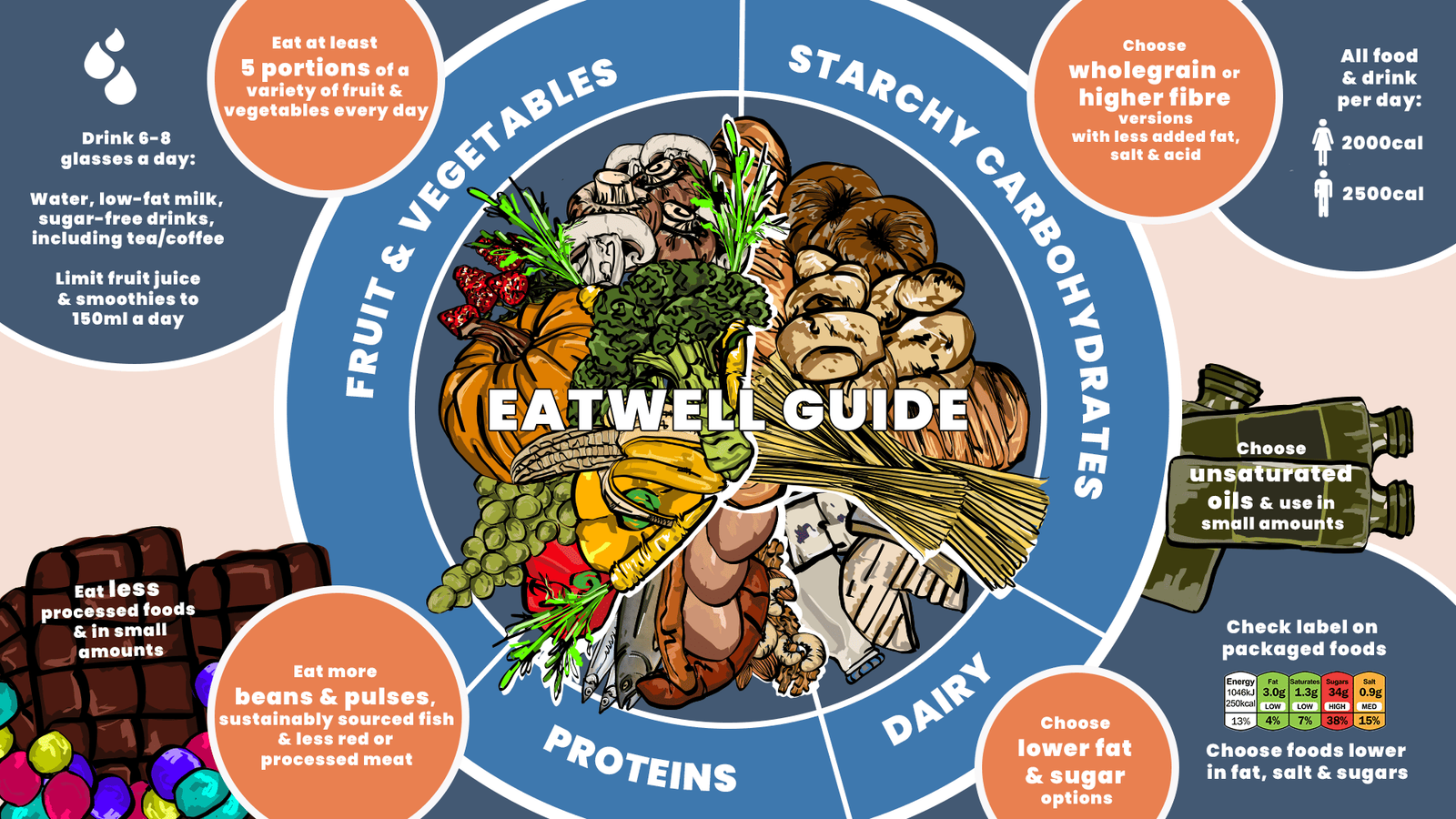
What is the Eatwell Guide? A balanced diet explained
Peer reviewed by Dr Krishna Vakharia, MRCGPAuthored by Victoria RawOriginally published 25 Oct 2024
Meets Patient’s editorial guidelines
- DownloadDownload
- Share
- Language
- Discussion
The UK government's National Diet and Nutrition Survey (NDNS) found a worrying drop in people's intake of important nutrients in the UK. Even with access to a wide range of information on the subject, many people still aren't sure what makes up a balanced diet. However, if you're feeling overwhelmed by dietary bumf, the Eatwell Guide offers a simple easy-to-follow framework for healthy eating.
In this article:
The Eatwell Guide is a useful way of knowing how much of each food group you should eat to stay healthy. The Health and Food Supplement Information Service (HSIS) says that including each of these groups in your diet can help reduce your chance of developing some serious health conditions such as heart disease, diabetes and stroke.
Continue reading below
What is the Eatwell Guide?
The Eatwell Guide - created by Public Health England - is a tool that shows the recommended amounts of different food groups needed for a healthy diet. It breaks down the perfect proportions of these groups in a simple, visual way.
Isabelle Spellissy, registered associate nutritionist, Innermost, London, UK explains: "The Eatwell Guide acts as a general framework for a balanced diet, and is designed to be adaptable for the UK population. Its recommendations are broader than some diets - such as the Mediterranean diet - though it still emphasises the importance of eating fruits, vegetables, whole grains and lean protein sources."
Sebnem Unluisler, Chief Longevity Officer and Genetic Engineer, London Regenerative Institute says that the Eatwell Guide provides guidance on the types and amounts of foods you should eat to make sure your body receives all the necessary nutrients.
These foods are divided into five main groups:
Fruits and vegetables - these should make up more than one third of your daily food intake, and include the recommended five portions of fruit and veg a day.
Starchy carbohydrates - such as whole grain bread, brown rice, and potatoes, which should also make up one third.
Proteins - such as beans, pulses, fish, eggs, and lean cuts of meat and mince, with a focus on variety, including plant-based sources.
Dairy or dairy alternatives - should be low-fat or lower-sugar options.
Oils and spreads - to be used in small amounts, prioritising unsaturated fats over saturated and trans fats.
"The Guide advises that you reduce your intake of foods high in fat, sugar, and salt - such as sweets, fried foods, and sugary drinks," says Unluisler. "It encourages you to drink water as your go-to beverage, suggesting low-fat milk or unsweetened drinks as alternatives."
The Eatwell Guide

Source: Public Health England in association with the Welsh Government, Food Standards Scotland and the Food Standards Agency in Northern Ireland
Graphic: Ben Hudson
How can the Eatwell Guide help you?
A nutritious diet is crucial for your wellbeing. A balanced intake of nutrients can boost energy, maintain a healthy weight, and keep your body functioning well.
Spellissy says: "By focusing on a variety of food groups, the Eatwell Guide ensures you're getting all the necessary vitamins, minerals, fibre and healthy fats needed for overall wellness."
Healthy ageing plays a crucial role in maintaining cellular health, and reducing your chance of age-related conditions.
Unluisler says: "A high intake of fruits and vegetables - rich in vitamins, minerals and antioxidants - will protect your skin, and reduce the signs of ageing."
According to Unluisler, a balanced intake of proteins, healthy fats and carbohydrates can:
Support heart health.
Lower cholesterol and blood pressure.
Protect your brain against cognitive decline.
Improve mood and mental well-being.
Reduce symptoms of anxiety and depression.
She adds that by encouraging the consumption of whole grains and limiting sugary foods, following the Eatwell Guide can contribute to stable blood sugar levels, reducing the likelihood of insulin resistance and type 2 diabetes.
Continue reading below
Who should follow the Eatwell Guide?
The Eatwell Guide is designed to serve a wide range of the UK population, making it a suitable dietary model for most people - including children over two years of age, and older adults.
Spellissy says, that people with specific dietary needs may need to modify certain aspects of the Eatwell Guide to fit their personal nutritional requirements.
People with the following conditions may need to adjust their portions or food choices:
Food allergies or intolerances - such as lactose intolerance.
Medical conditions - such as coeliac disease, kidney disease, diabetes.
"Adjustments might also be required if you're pregnant, an athlete, older, or following a vegetarian or vegan diet," adds Spellissy.
How to use the Eatwell Guide
The Eatwell Guide - Source: Public Health England
Planning meals and controlling portion sizes help make the Eatwell Guide easier to follow, and ensure you're following its daily recommendations.
Spellissy advises you start by filling half your plate with fruits and vegetables - a quarter with starchy carbohydrates, preferably whole grains, and the remaining quarter with protein.
An example of a healthy, well-balanced plate might include:
Seasoned or spiced grilled chicken - protein.
Wholegrain rice - starch.
A colourful variety of roasted vegetables - such as broccoli, carrots and bell peppers.
A glass of water, milk, or a sugar-free drink.
Unluisler recommends the following tips for incorporating healthier foods:
Go for healthy snacks - such as fruit, nuts or yoghurt.
Cut down your intake of processed foods.
Choose healthier cooking methods - such as baking, grilling or steaming.
Try new recipes that incorporate different food groups - these could include stir-fries or salads that combine various vegetables and proteins.
If you have specific dietary needs you should work with a registered dietitian to customise the Eatwell Guide to your requirements. This will ensure you're meeting your nutritional goals, while addressing any health concerns.
Patient picks for Diet

Diet and nutrition
What is the Korean diet?
The Korean Diet - often called the K-diet - is rooted in the traditional foods commonly enjoyed in Korea. With the global rise in Korean culture’s popularity, interest in the K-Diet has surged, largely due to its apparent health benefits. We look at what the K-Diet involves, and whether it's good for you.
by Victoria Raw

Diet and nutrition
What is the Whole30 diet?
Many physical and mental problems are linked to what you eat. Perhaps you're struggling with a lack of energy, poor sleep, digestive issues, or low mood - how do you work out if what you're eating is to blame? The Whole30 diet is a highly restrictive, 30-day elimination diet that claims to get you these answers. Celebrities like Busy Phillips and Emmy Rossum have described the Whole30 diet as intense but worthwhile. We sift through the hype and ask if Whole30 is grounded in evidence - or if it's just another fad.
by Amberley Davis
Continue reading below
Article history
The information on this page is peer reviewed by qualified clinicians.
Next review due: 25 Oct 2027
25 Oct 2024 | Originally published
Authored by:
Victoria RawPeer reviewed by
Dr Krishna Vakharia, MRCGP

Ask, share, connect.
Browse discussions, ask questions, and share experiences across hundreds of health topics.

Feeling unwell?
Assess your symptoms online for free
Sign up to the Patient newsletter
Your weekly dose of clear, trustworthy health advice - written to help you feel informed, confident and in control.
By subscribing you accept our Privacy Policy. You can unsubscribe at any time. We never sell your data.